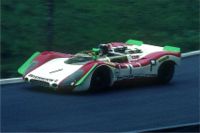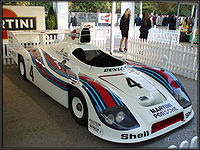
Group 6 (racing)
Encyclopedia
Group 6 was the official designation applied by the FIA
to two motor racing classifications, the Prototype-Sports Car category from 1966 to 1971 and the Two-Seater Racing Cars class from 1976 to 1982.
 . The original Group 6 was introduced for the 1966 racing season, at the same time as a new Group 4
. The original Group 6 was introduced for the 1966 racing season, at the same time as a new Group 4
Sports Car category. Whilst Group 4 specified that competing cars must be one of at least fifty examples built, Group 6 had no minimum production requirement. Nor did it have a maximum engine capacity limit although there were weight, dimensional and other restrictions placed on the Group 6 cars. The Prototypes and Sports Cars categories each had their own international championships to fight for but many of the major international endurance races such as the 24 Hours of Le Mans
would count as qualifying rounds for both championships.
1968 saw a three litre engine capacity limit imposed on the Group 6 category and the dual championship format was replaced by a single International Championship for Makes
open to both Group 6 and Group 4 cars. The Le Mans 24 Hour retained its place as a championship round. For 1969 the FIA relaxed a number of Group 6 regulations relating to weight, spare wheel, windscreen height and luggage space requirements.
For 1972 the Group 6 Prototype-Sports Car class was redesignated and renamed to become the Group 5
Sports Car category. The International Championship of Makes became the World Championship of Makes
and the first chapter of Group 6 history was brought to a close by the FIA.
Group 6 cars had been eligible to compete in 24 Hours of Le Mans each year from 1966 to 1971; however the category had produced the outright winning car only in 1966 and 1967.
 In 1976, the FIA reintroduced the Group 6 classification, now officially called “Two- Seater Racing Cars”. Three engine capacity limits were applied
In 1976, the FIA reintroduced the Group 6 classification, now officially called “Two- Seater Racing Cars”. Three engine capacity limits were applied
Various production based categories, spearheaded by a new Group 5
for “Special Production Cars”, were now to contest the World Championship of Makes whilst the Group 6 cars were awarded their own title, the World Championship for Sports Cars
.
After two years of small fields and little in the way of manufacturer support the championship was downgraded to become the European Sports Car Championship for 1978 but even that title was to be abandoned after the first year. From 1979 the FIA decreed that Group 6 cars could compete in the World Championship of Makes qualifying rounds but continued to allow only production based cars to score championship points for their manufacturer.
1981 saw the series expanded with an official Drivers’ title awarded by the FIA for the first time and drivers of Group 6 cars were eligible to compete for this. Group 6 was then effectively replaced by the new Group C Sports Car
class for 1982 but the FIA granted a concession which allowed the Group 6 cars to compete in the 1982 World Endurance Championship
alongside the new cars. As in 1981, drivers of Group 6 cars were eligible to score points in the Drivers’ championship but the relevant manufacturers could not score points towards the Makes title.
Throughout the seven years of the second era of Group 6 racing the cars had been eligible to compete in 24 Hours of Le Mans
and the category had produced the outright winning car in all years except 1979 & 1982.
Fédération Internationale de l'Automobile
The Fédération Internationale de l'Automobile is a non-profit association established as the Association Internationale des Automobile Clubs Reconnus on 20 June 1904 to represent the interests of motoring organisations and motor car users...
to two motor racing classifications, the Prototype-Sports Car category from 1966 to 1971 and the Two-Seater Racing Cars class from 1976 to 1982.
Group 6 Prototype-Sports Cars (1966 to 1971)

Group 4 (racing)
The Group 4 racing class referred to regulations for cars in sportscar racing, GT racing and rallying, as regulated by the FIA. The Group 4 class was replaced by Group B for the 1983 season.-Production requirements:...
Sports Car category. Whilst Group 4 specified that competing cars must be one of at least fifty examples built, Group 6 had no minimum production requirement. Nor did it have a maximum engine capacity limit although there were weight, dimensional and other restrictions placed on the Group 6 cars. The Prototypes and Sports Cars categories each had their own international championships to fight for but many of the major international endurance races such as the 24 Hours of Le Mans
24 Hours of Le Mans
The 24 Hours of Le Mans is the world's oldest sports car race in endurance racing, held annually since near the town of Le Mans, France. Commonly known as the Grand Prix of Endurance and Efficiency, race teams have to balance speed against the cars' ability to run for 24 hours without sustaining...
would count as qualifying rounds for both championships.
1968 saw a three litre engine capacity limit imposed on the Group 6 category and the dual championship format was replaced by a single International Championship for Makes
World Sportscar Championship
The World Sportscar Championship was the world series run for sports car racing by the FIA from 1953 to 1992.The championship evolved from a small collection of the most important sportscar, endurance and road racing events in Europe and North America with dozens of gentleman drivers at the grid,...
open to both Group 6 and Group 4 cars. The Le Mans 24 Hour retained its place as a championship round. For 1969 the FIA relaxed a number of Group 6 regulations relating to weight, spare wheel, windscreen height and luggage space requirements.
For 1972 the Group 6 Prototype-Sports Car class was redesignated and renamed to become the Group 5
Group 5 (racing)
Group 5 was an FIA motor racing classification which was applied to four distinct categories during the years 1966 to 1982. Initially Group 5 regulations defined a Special Touring Car category and from 1970 to 1971 the classification was applied to limited production Sports Cars restricted to 5...
Sports Car category. The International Championship of Makes became the World Championship of Makes
World Sportscar Championship
The World Sportscar Championship was the world series run for sports car racing by the FIA from 1953 to 1992.The championship evolved from a small collection of the most important sportscar, endurance and road racing events in Europe and North America with dozens of gentleman drivers at the grid,...
and the first chapter of Group 6 history was brought to a close by the FIA.
Group 6 cars had been eligible to compete in 24 Hours of Le Mans each year from 1966 to 1971; however the category had produced the outright winning car only in 1966 and 1967.
Group 6 Two-Seater Racing Cars (1976 to 1982)

- 5000cc for cars fitted with “stockblock” engines
- 3000cc for cars fitted with naturally aspirated racing engines
- 2100cc for cars fitted with turbocharged racing engines
Various production based categories, spearheaded by a new Group 5
Group 5 (racing)
Group 5 was an FIA motor racing classification which was applied to four distinct categories during the years 1966 to 1982. Initially Group 5 regulations defined a Special Touring Car category and from 1970 to 1971 the classification was applied to limited production Sports Cars restricted to 5...
for “Special Production Cars”, were now to contest the World Championship of Makes whilst the Group 6 cars were awarded their own title, the World Championship for Sports Cars
World Sportscar Championship
The World Sportscar Championship was the world series run for sports car racing by the FIA from 1953 to 1992.The championship evolved from a small collection of the most important sportscar, endurance and road racing events in Europe and North America with dozens of gentleman drivers at the grid,...
.
After two years of small fields and little in the way of manufacturer support the championship was downgraded to become the European Sports Car Championship for 1978 but even that title was to be abandoned after the first year. From 1979 the FIA decreed that Group 6 cars could compete in the World Championship of Makes qualifying rounds but continued to allow only production based cars to score championship points for their manufacturer.
1981 saw the series expanded with an official Drivers’ title awarded by the FIA for the first time and drivers of Group 6 cars were eligible to compete for this. Group 6 was then effectively replaced by the new Group C Sports Car
Group C
Group C was a category of motorsport, introduced by the FIA in 1982 for sports car racing, along with Group A for touring cars and Group B for GTs....
class for 1982 but the FIA granted a concession which allowed the Group 6 cars to compete in the 1982 World Endurance Championship
World Sportscar Championship
The World Sportscar Championship was the world series run for sports car racing by the FIA from 1953 to 1992.The championship evolved from a small collection of the most important sportscar, endurance and road racing events in Europe and North America with dozens of gentleman drivers at the grid,...
alongside the new cars. As in 1981, drivers of Group 6 cars were eligible to score points in the Drivers’ championship but the relevant manufacturers could not score points towards the Makes title.
Throughout the seven years of the second era of Group 6 racing the cars had been eligible to compete in 24 Hours of Le Mans
24 Hours of Le Mans
The 24 Hours of Le Mans is the world's oldest sports car race in endurance racing, held annually since near the town of Le Mans, France. Commonly known as the Grand Prix of Endurance and Efficiency, race teams have to balance speed against the cars' ability to run for 24 hours without sustaining...
and the category had produced the outright winning car in all years except 1979 & 1982.

